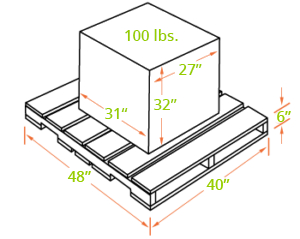Density Calculator
LTL Shipments are rated using the NMFC classification guidelines. The world of LTL freight is often a complex and typically is a difficult part of freight shipping to manage. Determining the right freight class can save you both time and money. We’ve created an easy-to-use calculator to help you choose the right freight class and accurately plan your shipment.
Palletized Dimensions.
Example

Freight Classification
Freight class reference chart
Class Name | Examples | Freight Density in lbs per cubic foot |
Class 50 | Fits on standard shrink-wrapped 4x4 pallet, very durable | 50 pounds |
Class 55 | Bricks, cement, mortar, hardwood flooring | 35 but less than 50 pounds |
Class 60 | Car accessories & car parts | 30 but less than 35 pounds |
Class 65 | Car accessories & car parts, bottled beverages, books in boxes | 22.5 but less than 30 pounds |
Class 70 | Car accessories & car parts, food items, automobile engines | 15 but less than 22.5 pounds |
Class 77.5 | Tires, bathroom fixtures | 13.5 but less than 15 pounds |
Class 85 | Crated machinery, cast iron stoves | 12 but less than 13.5 pounds |
Class 92.5 | Computers, monitors, refrigerators | 10.5 but less than 12 pounds |
Class 100 | Boat covers, car covers, canvas, wine cases, caskets | 9 but less than 10.5 pounds |
Class 110 | Cabinets, framed artwork, table saw | 8 but less than 9 pounds |
Class 125 | Small Household appliances | 7 but less than 8 pounds |
Class 150 | Auto sheet metal parts, bookcases | 6 but less than 7 pounds |
Class 175 | Clothing, couches, stuffed furniture | 5 but less than 6 pounds |
Class 200 | Auto sheet metal part, aluminum table, packaged mattresses | 4 but less than 5 pounds |
Class 250 | Bamboo furniture, mattress and box spring, plasma TV | 3 but less than 4 pounds |
Class 300 | Wood cabinets, tables, chairs setup, model boats | 2 but less than 3 pounds |
Class 400 | Deer antlers | 1 but less than 2 pounds |
Class 500 | Low Density or High Value Highest Cost Bags of gold dust, ping pong balls | Less than 1lbs. |
Disclaimer
The information and tools on this page are intended to only be a resource to be used as a general guideline into the characteristics and attributes that are used by the National Motor Freight Traffic Association, Inc. in determining freight classes. The information and tools on this page are not in any way intended to be a calculator for determining the exact actual freight class of your commodities.
The most truly accurate method to ensure the accurate determination of freight class is to utilize The National Motor Freight Classification® (NMFC®) which is published by the National Motor Freight Traffic Association, Inc. More information can be found on this at The National Motor Freight Traffic Association’s website www.nmfta.org/pages/nmfc.
The National Motor Freight Traffic Association also makes the full National Motor Freight Classification® (NMFC®) on-line tool called ClassIT® which is available for a fee www.classit.nmfta.org/all/Welcome.aspx.
Failure to accurately determine the actual freight class of your items being shipped can result in significantly different and higher rating and carrier billings.
Talk to one of our experienced freight specialists if you have any questions in determining your freight class. If you are unsure of the proper NMFC commodity class we can assist.
TL freight shipping
LTL freightshipping
Intermodaltransportation
